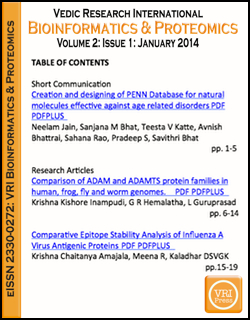
Comparative Epitope Stability Analysis of Influenza A Virus Antigenic Proteins
Abstract
Influenza A Viruses are the most virulent human pathogens among the three influenza types (Influenza A, B, C) and cause the most severe disease. The influenza A virus are subdivided into different serotypes based on the antibody response to these viruses and they resulted in many number of human pandemic deaths. The known flu pandemics are from 1918 Spanish flu, which is the serious pandemic in recent history and the most recent one was the 2009 flu pandemic. In each of the pandemics, different subtypes of H & N of Influenza A virus strain are involved. The process of antigenic shift in between species as well subtype combinations are leading to the novel strains which are highly virulent. As the subtypes are based on two important proteins viz. Hemagglutinin and Neuraminidase (H&N), our focus is to identify the amino acid changes/mutations in the epitopes of H1-H16 and N1-N9 strains which are evolved through time. The epitopic regions are predicted using Immune Epitope DataBase, and the predicted epitopic peptide is modeled using the CPH modeling server and each of the modeled epitope(s) are subjected to structural stability analysis using Hyperchem program. Epitope modeling and energy value comparison studies of Influenza A Virus epitopes showed that recent (2010) strains - H5 and N6 are possessing higher energies indicating their instability and thereby are more prone to mutations and may become highly pathogenic (virulent) in the near future than the earlier H1 and N1 strains.
Keywords
References
Yasuo SUZUKI: Sialobiology of Influenza: Molecular Mechanism of Host Range Variation of Influenza Viruses. Biol Pharm Bull. 2005 Mar;28(3):399-408.
http://dx.doi.org/10.1248/bpb.28.399
Gong J, Xu W, Zhang: Structure and functions of influenza virus neuraminidase. J.Curr Med Chem. 2007;14(1):113-22.
http://dx.doi.org/10.2174/092986707779313444
PMid:17266572
Webster RG, Bean WJ, Gorman OT, Chambers TM, Kawaoka Y: Evolution and ecology of influenza A viruses. Microbiol Rev. 1992 Mar;56(1):152-79.
PMid:1579108 PMCid:PMC372859
Jason AG, Maya FK, Yohan K, Carla O, Kerrie V, Nima S, Randi V, Julia P, Richard HS, Alessandro S, Bjoern P: Pre-existing immunity against swine-origin H1N1 influenza viruses in the general human population, PNAS, 106(48), 2009, 20365-20370.
http://dx.doi.org/10.1073/pnas.0911580106
PMid:19918065 PMCid:PMC2777968
Easton DM, Nijnik A, Mayer ML, Hancock RE: Potential of immunomodulatory host defense peptides as novel anti-infectives. Trends Biotechnol. 27(10), 2009, 582-590.
http://dx.doi.org/10.1016/j.tibtech.2009.07.004
PMid:19683819
Khanna M, Gupta N: Influenza A (H1N1) pandemic: preparedness and clinical management. Indian J Exp Biol, 47(11), 2009, 929-32.
PMid:20099469
Amajala Krishna Chaitanya, VSV Ravi Chandu, DSVGK Kaladhar, I Bhaskar Reddy.: Epitope Modeling, Comparative Mutation & Structural Stability Analysis of Influenza A Virus H1N1, Drug Invention Today, 2012, 4(3), 351-354.
Taubenberger JK, Morens DM: The pathology of influenza virus infections. Annu Rev Pathol. 2008;3:499-522.
http://dx.doi.org/10.1146/annurev.pathmechdis.3.121806.154316
PMid:18039138 PMCid:PMC2504709
Zhang Q, Wang P, Kim Y, Haste-Andersen P, Beaver J, Bourne PE, Bui HH, Buus S, Frankild S, Greenbaum J, Lund O, Lundegaard C, Nielsen M, Ponomarenko J, Sette A, Zhu Z, Peters B: Immune epitope database analysis resource (IEDB-AR). Nucleic Acids Res, 36, 2008, W513-8.
http://dx.doi.org/10.1093/nar/gkn254
PMid:18515843 PMCid:PMC2447801
Boeckmann B, Bairoch A, Apweiler R, Blatter MC, Estreicher A, Gasteiger E, Martin MJ, Michoud K, O'Donovan C, Phan I. et al.: The SWISS-PROT protein knowledgebase and its supplement TrEMBL in 2003. Nucleic Acids Res. 2003;8(1):365–370. doi: 10.1093/nar/gkg095.
http://dx.doi.org/10.1093/nar/gkg095
Nielsen M., Lundegaard C., Lund O., Petersen TN: CPHmodels-3.0 - Remote homology modeling using structure guided sequence profiles. Nucleic Acids Research, 2010, Vol. 38, doi:10.1093/nar/gkq535.
http://dx.doi.org/10.1093/nar/gkq535
HyperChem(TM) Professional 7.51, Hypercube, Inc., 1115 NW 4th Street, Gainesville, Florida 32601, USA.
Tamura K, Peterson D, Peterson N, Stecher G, Nei M, and Kumar S: MEGA5: Molecular Evolutionary Genetics Analysis using Maximum Likelihood, Evolutionary Distance, and Maximum Parsimony Methods. Molecular Biology and Evolution 2011, 28: 2731-2739.
http://dx.doi.org/10.1093/molbev/msr121
PMid:21546353 PMCid:PMC3203626
DOI: http://dx.doi.org/10.14259%2Fbp.v2i1.86
Refbacks
- There are currently no refbacks.








